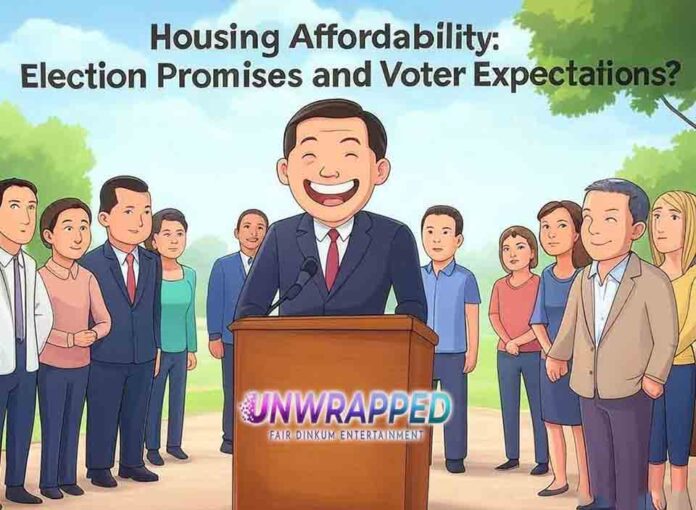Housing affordability is set to be a defining issue in the 2025 Australian Federal Election, with both major parties and independents promising solutions to one of the nation’s most pressing challenges. Rising rents, soaring property prices, and stagnant wages have left many Australians grappling with the reality of homeownership slipping further out of reach.
This article delves into the election promises surrounding housing affordability, the policies on the table, and what voters expect from their leaders in addressing this critical issue.
The Current State of Housing in Australia
Rising Prices
Australia’s housing market has seen a decade of dramatic price increases. In 2025:
- Median house prices in major cities like Sydney and Melbourne exceed $1 million.
- Regional areas have also experienced sharp increases due to pandemic-era relocations.
(Learn more: CoreLogic Housing Data)
Rental Affordability Crisis
Renters face record-high costs:
- The national vacancy rate is below 1%, pushing rents to unprecedented levels.
- Essential workers in cities struggle to live near their workplaces, exacerbating commuting stress.
(Read more: ABC News Housing Affordability)
Election Promises from Major Parties
Labor Party’s Housing Affordability Plan
1. National Housing Accord
Labor promises to build 1 million new affordable homes by 2030, focusing on:
- Partnerships with state governments and private developers.
- Inclusion of social and community housing projects.
2. Help to Buy Scheme
The Help to Buy Scheme assists first-home buyers by:
- Allowing the government to co-purchase up to 40% of a new home.
- Reducing the deposit and loan burden on buyers.
3. Support for Renters
Labor also proposes:
- Capping rent increases for tenants in federally funded housing projects.
- Expanding rental assistance for low-income earners.
(Explore Labor’s housing policies: Labor Party Platform)
Coalition’s Housing Policy
1. Supply and Incentives
The Coalition emphasizes increasing housing supply by:
- Encouraging private developers through tax incentives.
- Supporting regional growth with infrastructure investment to ease urban housing pressures.
2. First Home Loan Deposit Scheme
- Offers first-home buyers the opportunity to purchase a home with as little as 5% deposit.
- The government guarantees a portion of the loan, reducing the need for lenders’ mortgage insurance.
3. Support for Downsizing
- Proposes tax breaks for retirees downsizing their homes, freeing up larger properties for families.
(Learn about the Coalition’s housing policy: Liberal Party Platform)
The Greens’ Bold Housing Proposals
1. Universal Housing as a Right
The Greens propose making housing a universal right by:
- Building 1 million publicly owned homes over 20 years.
- Expanding funding for community housing providers.
2. Rent Controls
- Introduces nationwide rent caps to prevent exploitative increases.
- Offers direct rental subsidies to low-income tenants.
3. Ending Negative Gearing
The Greens aim to phase out negative gearing on investment properties to curb speculative buying and free up housing for owner-occupiers.
(Explore the Greens’ housing platform: The Greens Policy)
Comparing Party Policies on Housing Affordability
| Policy Area | Labor | Coalition | Greens |
|---|---|---|---|
| Affordable Housing Supply | 1 million homes by 2030 | Tax incentives for developers | 1 million public homes over 20 years |
| First-Home Buyer Assistance | Help to Buy Scheme | First Home Loan Deposit Scheme | Targeted funding for first-home buyers |
| Renters’ Protections | Caps on rent increases | Minimal intervention | Nationwide rent caps |
| Negative Gearing | No changes | No changes | Phase-out proposed |
Voter Expectations on Housing Affordability
1. Action, Not Promises
Voters, particularly Millennials and Gen Z, are demanding tangible results over political rhetoric. These generations make up a growing share of the electorate and are disproportionately affected by housing challenges.
2. Support for Renters
With over 30% of Australians renting, policies addressing rental affordability are expected to resonate strongly.
3. Regional Solutions
Regional Australians want investment in infrastructure and services to make housing in these areas a viable alternative to urban living.
Challenges in Addressing Housing Affordability
1. Balancing Supply and Demand
Simply increasing supply may not address affordability without measures to curb speculative investments.
2. Economic Constraints
Tackling the housing crisis requires significant investment, raising concerns about budget deficits and national debt.
3. Coordination Across Governments
Housing policy involves federal, state, and local governments, necessitating collaboration that is often difficult to achieve.
What’s at Stake in 2025?
1. Economic Impact
Affordable housing is critical to economic stability. Rising costs strain household budgets, reducing spending in other areas and impacting broader economic growth.
2. Social Equity
Housing affordability is also a question of fairness. Without intervention, the gap between homeowners and renters will continue to grow.
3. Political Implications
Housing affordability is a top issue for many Australians, making it a decisive factor in the 2025 election. The party that convincingly addresses this crisis could gain significant political leverage.
(Explore housing insights: Grattan Institute)
How Voters Can Stay Informed
1. Compare Party Platforms
2. Attend Community Forums
Engage with candidates directly to ask about their housing policies and plans.
3. Use Online Tools
Interactive tools like the ABC Vote Compass provide insights into how party policies align with your priorities.
(Visit: ABC Vote Compass)
Conclusion: Choosing the Future of Housing
Housing affordability is not just an economic issue—it’s a cornerstone of Australian life and an essential factor in ensuring social stability and equity. As the 2025 election approaches, voters face a choice between distinct approaches to solving the housing crisis.
Will Australia build a future where housing is a right, not a privilege? That decision lies with voters. Share your thoughts in the comments below or join the conversation on social media. Together, we can shape the future of housing in Australia.
External Resources
See Also: Climate Change Commitments: Where Do the Parties Stand in 2025?










